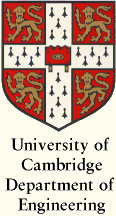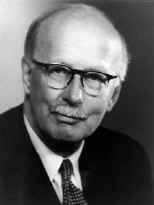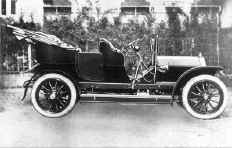
A PIONEER OF THE INTERNAL COMBUSTION ENGINE
Sir Harry Ricardo F.R.S.
1885 - 1974

 |
A PIONEER OF THE INTERNAL COMBUSTION ENGINE Sir Harry Ricardo F.R.S. 1885 - 1974
|
 |
THIS EXHIBITION IS A TRIBUTE TO A CAMBRIDGE
ENGINEERING STUDENT, H.R. RICARDO, WHO GRADUATED IN 1906. THROUGHOUT HIS UNDERGRADUATE
DAYS HE WAS PREOCCUPIED WITH IDEAS FOR THE DEVELOPMENT OF THE INTERNAL COMBUSTION ENGINE,
AND MANY OF THE IDEAS THAT WERE TO LATER BEAR FRUIT WERE CONCEIVED IN THIS PERIOD.
HE WAS THE FOUNDER AND TECHNICAL DIRECTOR OF A SUCCESSFUL COMPANY, FORMED TO CARRY
OUT CONSULTATIVE AND RESEARCH WORK, KNOWN AS RICARDO & CO. ENGINEERS(1927) LTD.
|
1. BIOGRAPHICAL & REFERENCES
The foundations of Ricardo's career were laid when he helped professor Hopkinson with his research work at Cambridge, but he first became well known when he designed the outstandingly successful engine for tanks when they were first used in the 1914-18 war. After this war he investigated fuels for petrol engines, and this resulted in drastic changes in the refining and marketing policies of the Shell organisation.
In the 1920s he founded and built up the consulting and research firm of Ricardo & Co. at Shoreham. This firm has reached a well-nigh unique position, of great value to the internal combustion engine industry, and Sir Harry’s personality has become a byword in these circles.
He again contributed to his country’s victory in the 1939-45 war; the Bristol Aeroplane Co. based their sleeve valve engine on Sir Harry’s work. Altogether, 130,000 sleeve valve aero engines were built mostly by the Bristol and Napier companies.
He has also left his mark on diesel engines. The well known Ricardo "Comet" combustion system has been built into engines all over the world by numerous licensees.
Ricardo was knighted in 1948 in recognition of his work in the field of internal combustion engineering and research.
References
(1) "Presidential Address", Institution of Mechanical Engineers, 1944 (Proc. I. Mech. E., 152, 1945)
(2) "Horning Memorial Lecture, 1955" (Chartered Mechanical Engineer, September, 1955)
(3) Unpublished Technical Notes by Sir Harry Ricardo. (These notes subsequently
formed the basis of his book:
Memories and Machines published by Constable in 1968.)
2. CAMBRIDGE: START OF A CAREER
Work at Cambridge with Professor Hopkinson
"At Cambridge I started working for the Mechanical Sciences Tripos, but
after my first year, Professor Hopkinson invited me to assist him in some researches
he was about to undertake into the internal combustion engine. Up to that time,
I had taken no special interest in internal combustion engines as such, though
the advent of the motor-car, then a fascinating but wayward mechanical toy,
had, of course, thrilled me......"
"Hopkinson had his eyes fixed always on the light high-speed engine as
the internal combustion engine of the future, and prophesied that, given sufficient
turbulence, there was no limit in sight to the speed at which an internal combustion
engine could run, and run efficiently; and even today, no such limit is yet
in sight......"
"In retrospect I am amazed at the ground Hopkinson covered in so short a time and at his ingenuity in devising very simple but convincing experiments, involving the absolute minimum of equipment. His lectures and administrative duties left him very little time, and there was no grant of money for research; I, too, had to attend lectures and work for my degree, yet we were never in a hurry, we certainly never burned the midnight oil or missed a single meal or entertainment......" [MORE]
3. THE DOLPHIN ENGINE
The design and development of this engine was one of Sir Harry Ricardo’s first commercial ventures:
"I designed and built in the workshops at Cambridge the first version while I was an undergraduate in 1903-04. This gave quite a promising performance. I then designed and built, also in the workshops at Cambridge, an improved version, which was completed in 1905 and was put through fairly thorough calibration tests in the engineering laboratory. After leaving Cambridge I experimented a good deal in my own small workshop with this engine in my own spare time......"
A small firm, Messrs Lloyd and Plaister, became interested in the engine and Ricardo designed two sizes of the engine for a small and a large car. The small model was a fair success, about 50 being produced before the death of Mr. Lloyd and the outbreak of the 1914 war halted production. In 1909 however Sir Harry designed a two-stroke 3. 3 litre engine for his cousin Ralph Ricardo who had started a small concern, "a very amateurish one", in a yard at Shoreham. This engine was used in the Dolphin car..... [MORE]
| The Dolphin Engine: Cross- Section | The Dolphin Engine fitted up for Brake Testing | ||
 |
The Dolphin Car 1908 | Engine for Le Zebra Car | |
| Le Zebra Car | Le Zebra
Car Saloon |
4. FIRST WORLD WAR TANK ENGINES
"Early in 1915 I received a letter from Hopkinson, with whom I had rather lost touch for some years, saying that he had been appointed as Technical Director of the newly formed Air Ministry, that since our work together at Cambridge he had grown rather rusty on the subject of internal combustion engines and asking me to prepare for him a note setting forth my own views on the principal factors governing the design and performance of light, high-speed engines......"
"It was relatively easy to screen the tanks from aerial observation even when close behind the front line, but all camouflage would be useless in the face of exhaust smoke (which was plentiful in the existing sleeve valve Daimler engines). It seemed that all the automobile manufacturers already had their hands full, either with military vehicles or with aircraft engines which at that time had first priority. It was apparent, therefore, that an entirely new engine would have to be designed and built. Through my grandfather firm I was in touch with a number of the manufacturers of large industrial engines, such as Mirrlees, Crossley and others, and I was asked to canvass these to find out whether they had the capacity and were willing to tackle the construction of such an engine. I found them riot only willing hut eager to do this, but not to tackle the design, which they said was quite outside their range of experience. I reported this to Tennyson d’Eyncourt who replied: "You seem to have a pretty good idea of what is required. Will you undertake it?........."
"Looking back I think that the success of these engines was due very largely to the use of the crosshead piston. In general the piston is one of the most vulnerable parts of any internal combustion engine, but in the case of the crosshead piston, thanks to the very efficient air cooling and to its separate system of lubrication, the pistons themselves were virtually quite trouble-free. Once we had nailed down and cured the "barking dog" trouble, we never had the slightest trouble with the pistons......."
To sum up, I think the great success of the Tank engine, of which probably only about 75% were installed in Tanks. stemmed largely from the fact that they were by far the most powerful petrol engines apart from aviation engines available to the allies. It stemmed also, and above all I think, from the generous help and wonderful co-operation on the part of everyone concerned......." [MORE]
| Tank Engine | Sectional
Model of Tank Engine |
||
| Tank engines under construction | Tank going into action | ||
| Mark I
Tank 1916 |
Mark V Tanks |
THE TANK – Historical Note by K.A. Knell
In the 1914-18 War once the fronts were stabilised the odds were
all on the defending side. While the machine-gun dominated the battlefield,
no frontal assault had much chance, and no flank attack was possible because
the Western Front had no flanks.
What might have been completely deadlock was finally broken by the extensive
use of the tank.....[MORE]
5. STRATIFIED CHARGE ENGINES
"Since the earliest days of the gas engine the advantage of working with a large excess of air and therefore at a lower cycle temperature has of course been well recognised, and the gain in thermodynamic efficiency from the reduction not only of direct heat losses but also of dissociation and that due to the changed specific heat of air at high temperatures has been well understood and evaluated. It is small wonder therefore that the lures of operating with a stratified charge should have attracted scores of inventors ever since the end of the last century, but despite extravagant claims to the contrary nobody yet has achieved any measure sure of success as applied to road service, which requires that it must apply to the entire range of torque from idling to maximum and that with repeated jumps from one extreme to the other at frequent intervals...... [MORE]
6. RACING MOTOR CYCLES AND CARS
One of the most famous of all Triumphs was the "Riccy" The engine was designed by that well-known authority on internal combustion engines, H. R. Ricardo (now Sir Harry Ricardo) - whence the name "Riccy" - and was, therefore, of very advanced design; there were several features which at that time, 1921, were startling novelties.....
In the Senior T.T. of 1921 a "Riccy" lay sixth for four laps, then slowed but finished. In other events these models were more successful, finishing 3rd in the 500 c.c. class of the Brooklands 500-mile race and the French G. P., capturing the 500 c.c. hour record, and taking the mile record flying start, at over eighty. With the improved engine, but handicapped by the loss of second gear, Walter Brandish finished 2nd in the Senior T.T. of 1922 at 56.22 m.p.h........ [MORE]
| Vauxhall Racing Car Engine |
Vauxhall Racing Car Engine & Gear Box |
||
| Vave Gear Timing Train |
Engine
Cross - Section |
7. COMBUSTION CHAMBER RESEARCH
One of the great contributions made by Ricardo to the internal combustion engine industry has been his development of the understanding of the phenomena controlling combustion in both the spark ignition engine and in the diesel engine. On the one hand he was one of the first to understand the part played by turbulence and the true nature of detonation; on the other his knowledge of the necessity for ordered relative air/fuel motion made possible the transition of the diesel from an engine akin to the reciprocating steam engine in size, weight, and speed to the small, compact units of today. Three notable advances in combustion chamber design are shewn below:
(a) The turbulent head (1919) for petrol engines. Ricardo realised that turbulence increased flame speed and achieved this by offsetting the cylinder head. He also recognised that it was the absolute distance travelled by the flame that increased the tendency to detonate so the chamber was made as compact as possible. Previous practice was to use a slab-like chamber as in (b)
(c) The induction swirl chamber. This represents one of the earliest attempts to achieve orderly air motion in a diesel engine, the swirl being initiated by inclined ports and accentuated by forcing the air into a small cylindrical volume
(d) The Comet Mark III compression swirl chamber. The most famous of all diesel combustion chambers, this design embodied intense swirl with a reasonable rate of pressure rise and good fuel consumption. In its latest form it is still one of the most widely used chambers when, power rather than economy, is the prime consideration. It was the subject of a lengthy legal battle about infringement of Patent rights between Riccardo’s and Rootes’ Bros. won by Ricardo’s who were represented by a young lawyer named Stafford Cripps (later to become Chancellor of the Exchequer).
8. VARIABLE COMPRESSION RATIO ENGINES
The E-35 was the first variable compression engine designed by Sir Harry. On it much early classical work on the characteristics of (then) unknown hydrocarbons was undertaken and the concept of Highest Useful Compression Ratio derived.
"During the 1914-18 War, I came into contact with Sir Robert Waley-Cohen, of the Shell Company, who, at that time, was chairman of a committee dealing with fuel supplies. To him I told of my experiments on detonation, of the very great importance I attached to it, and of my belief that it was largely a function of the fuel......." [MORE]
9. SLEEVE VALVE ENGINES
"About this time I had became very interested in aero-engines and built myself an experimental four-cycle engine with variable supercharge, with the object of maintaining ground-level power at high altitudes. This took about two years of spare time to make; it worked quite well, but in those days. I failed to rouse any interest in it, for I was met by the reply that aeroplanes would never fly high enough to need supercharging."
Sleeve Valve Aero Engines
E-25 Single sleeve valve single cylinder research engine. This engine carried
a load of 520 lb per sq. in. B. M. E. P. when engaged in supercharging tests
in the 1930s. From this kind of work was evolved the successful sleeve valve
aircraft engines which alone among the belligerents the British used. The Perseus,
Hercules, Taurus, Centaurus from Bristols, the Rolls-Royce Eagle, and the Napier
Sabre produced 200, 000, 000 H. P. during the war years. In fact the Rolls-Royce
Merlin and Griffon were the only common British poppet valve aircraft engines
by 1945.
As a result of the considerable amount of development work which Ricardo’s carried out on the sleeve valve engine this became a widely used form of construction for high powered British aircraft engines built during and after the 1939-45 War. Some 130, 000 were built by leading aero-engine manufacturers of which the examples illustrated below are best known...... [MORE]
| Bristol Perseus | Bristol Hercules | ||
| Bristol
Hercules Cutaway (View A) |
Bristol
Hercules Cutaway (View B) |
Above - Cutaway View of a Bristol
Hercules Sleeve Valve Engine
The sleeve, cylinder and piston have been cut to show more detail.
The shape of the ports can be clearly seen at the top of the sleeve.
10. PETROL AND DIESEL ENGINES FOR TRANSPORT
From the 1930s onwards Ricardo petrol and diesel engines were developed to power various makes of car including Bentley, Citroen and Peugeot. In 1951 Ricardo & Co. acted as consultants on the ‘FELL’ diesel-mechanical locomotive.
| Bently
Engine 1931 |
Sleeve
Valve Diesel (converted from Rolls-Royce Kestrel Engine) |
||
| Citroen Diesel Engine 1934 |
Peugeot Diesel Engine |
Above - "Fell" diesel-mechanical
locomotive on display at Marylebone, 1951
Ricardo & Co. were consultants on this project.
Ricardo & Co were also active in developing a range of compressors for various purposes. These included a special type of oxygen compressor made in some quantity for the Admiralty. Highly compressed oxygen will react with lubricating oil to form an explosive mixture. This reciprocating compressor was designed to have water lubrication. Great care was paid to the tolerances and to the choice of materials.
12. RICARDO'S STEAM ENGINE
The steam engine shown below was built in conjunction with the National Research and Development Corporation (the purpose of which is to finance likely inventions) with a view, to selling it on the Indian market. The idea was that the Indian village community should have some other source of power than bullocks, and this engine had a boiler which could burn any fuel including brushwood and camel dung. The scheme was not a success partly because the engine is still too elaborate, partly because oil engines are at least as convenient, and partly because the conservatism of the Indian village was underestimated.
Critics commented to Sir Harry that it was unusual for him to be interested in steam, after his reputation in the internal combustion engine world. He replied that his first love was steam..... [MORE]
13. RICARDO ON CONDUCTING RESEARCH
"To those of you who are about to carry out research of the kind I have been involved in, I would like to utter a few words of advice and a few warnings. First and foremost, make up your mind what to go for, that is to say what, in your judgement, will be likely to fulfil a need in say two or three years’ time; having once decided, keep that objective always clearly in view and do not, on any account, allow yourself to be side-tracked from it. Do not let yourself be too cast down by disappointment, or too elated by those initial successes, which so often prove to be only transitory. Do not be afraid of failures - here I speak with experience, for I have been responsible for many......" [MORE]
14. A NOTE ON 'SCIENCE IN WRITING'
In his book, Science in Writing, T.R. Henn discusses the gap between writing as practised in the Arts and in the Sciences. He deplores the obscure and deliberate cultivation of a mystery and encourages a return to clarity and simplicity. He provides extracts from great scientific writers from Francis Bacon to Max Born, and includes passages from Sir Harry Ricardo’s writings. [MORE]
15. FURTHER READING
H. R. Ricardo, Memories and Machines. Constable 1968.
H. R. Ricardo, The High-Speed Internal Combustion Engine. Blackie 1923. (4th edition 1953.)
L. R. Higgins, Britain’s Racing Motor-Cycles. Foulis 1953.
T.R. Henn, Science in Writing.
16. INTERNET and OTHER REFERENCES/LINKS
Ricardo plc Company Website
Trinity Sir Harry Ricardo's Cambridge College
© 2000 Cambridge University Engineering Department
| Photographs and diagrams from Sir Harry Ricardo's Presidential Address, 1944 (Proceedings of the Institution of Mechanical Engineers, vol. 152, 1945) are reproduced by courtesy of the Council of the Institution. |
Correspondence to: The Secretary, CUED, Trumpington Street, Cambridge CB2 1PZ, UK.
Web pages devised and compiled by K.C.A. Smith (Cambridge, Easter Term 2000).
Updated on 2nd June, 2000
Bernie Breton, bcb@eng.cam.ac.uk
Scientific Imaging Group